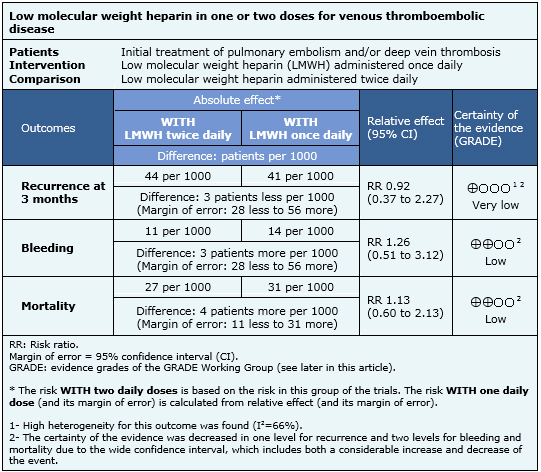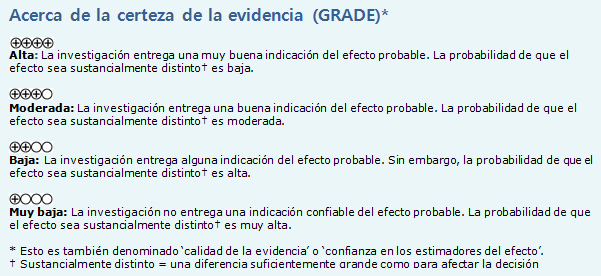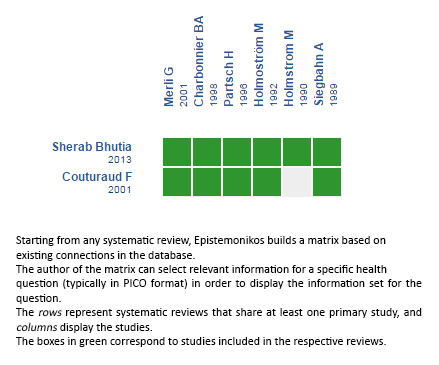 Para Descargar PDF debe Abrir sesión.
Para Descargar PDF debe Abrir sesión.
The preferred dosification for low molecular weight heparins is in two doses for most patients with venous thromboembolic disease. A daily dose would make treatment simpler, less expensive and more comfortable while retaining a similar benefit and safety. Searching in Epistemonikos database, which is maintained by screening 30 databases, we identified two systematic reviews including five randomized trials. We combined the evidence using meta-analysis and generated a summary of findings table following the GRADE approach. We concluded it is not clear whether the risk of recurrence differs between the two alternatives because the certainty of the evidence is very low, and that administering low molecular weight heparin in two doses might be associated to little or no difference in the risk of major bleeding and mortality.
There is wide consensus that low molecular weight heparins are part of the standard treatment for many patients with venous thromboembolic disease. Traditionally they are administered twice daily. However, a single daily dose could increase patient’s comfort, reduce costs and facilitate ambulatory treatment. However, it is not clear if this dosification has a similar benefit and safety profile.
We used Epistemonikos database, which is maintained by screening more than 30 databases, to identify systematic reviews and their included primary studies. With this information we generated a structured summary using a pre-established format, which includes key messages, a summary of the body of evidence (presented as an evidence matrix in Epistemonikos), meta-analysis of the total of studies, a summary of findings table following the GRADE approach and a table of other considerations for decision-making.
|
Key messages
|
| What is the evidence. See evidence matrix in Epistemonikos later |
We found two systematic reviews [1],[2] including five randomized controlled trials overall [3],[4],[5],[6],[7]. |
| What types of patients were included |
Patients with confirmed thromboembolic event: deep vein thrombosis and/or pulmonary embolism. Four studies included patients with deep vein thrombosis and one [5] included patients with pulmonary embolism or deep vein thrombosis. |
| What types of interventions were included |
All of the studies compared subcutaneous low molecular weight heparin administered once versus twice daily. Two studies used dalteparin [4],[6], one enoxaparin [5], one nadroparin [3] and one logiparin [7]. Four studies used the same daily dose in both arms and one [5] used 75% of the total dose in the once daily dose arm. |
| What types of outcomes were measured |
Symptomatic recurrence, major bleeding (intracranial, retroperitoneal, requiring transfusion, surgery or anticoagulant withdrawal, or as cause of death) during and 48 hours after treatment; total bleeding episodes; global mortality and cause-specific mortality (recurrence, bleeding); clot size increase in venography. |
The information is based on five randomized studies which included 1508 patients. Four studies reported all-cause mortality, three studies reported symptomatic recurrence at 3 months of follow up and five studies presented information on major bleeding during treatment with low molecular weight heparin.


|
To whom this evidence does and does not apply |
|
| About the outcomes included in this summary |
| Balance between benefits and risks, and certainty of the evidence |
|
| What would patients and their doctors think about this intervention |
|
| Resource considerations |
|
|
Differences between this summary and other sources |
|
| Could this evidence change in the future? |
|
Using automated and collaborative means, we compiled all the relevant evidence for the question of interest and we present it as a matrix of evidence.

Follow the link to access the interactive version: Low molecular weight heparin administered once versus twice daily for venous thromboembolism
The upper portion of the matrix of evidence will display a warning of “new evidence” if new systematic reviews are published after the publication of this summary. Even though the project considers the periodical update of these summaries, users are invited to comment in Medwave or to contact the authors through email if they find new evidence and the summary should be updated earlier. After creating an account in Epistemonikos, users will be able to save the matrixes and to receive automated notifications any time new evidence potentially relevant for the question appears.
The details about the methods used to produce these summaries are described here http://dx.doi.org/10.5867/medwave.2014.06.5997.
Epistemonikos foundation is a non-for-profit organization aiming to bring information closer to health decision-makers with technology. Its main development is Epistemonikos database (www.epistemonikos.org).
These summaries follow a rigorous process of internal peer review.
Conflicts of interest
The authors do not have relevant interests to declare.
 Esta obra de Medwave está bajo una licencia Creative Commons Atribución-NoComercial 3.0 Unported. Esta licencia permite el uso, distribución y reproducción del artículo en cualquier medio, siempre y cuando se otorgue el crédito correspondiente al autor del artículo y al medio en que se publica, en este caso, Medwave.
Esta obra de Medwave está bajo una licencia Creative Commons Atribución-NoComercial 3.0 Unported. Esta licencia permite el uso, distribución y reproducción del artículo en cualquier medio, siempre y cuando se otorgue el crédito correspondiente al autor del artículo y al medio en que se publica, en este caso, Medwave.

The preferred dosification for low molecular weight heparins is in two doses for most patients with venous thromboembolic disease. A daily dose would make treatment simpler, less expensive and more comfortable while retaining a similar benefit and safety. Searching in Epistemonikos database, which is maintained by screening 30 databases, we identified two systematic reviews including five randomized trials. We combined the evidence using meta-analysis and generated a summary of findings table following the GRADE approach. We concluded it is not clear whether the risk of recurrence differs between the two alternatives because the certainty of the evidence is very low, and that administering low molecular weight heparin in two doses might be associated to little or no difference in the risk of major bleeding and mortality.
 Autores:
Juan Pablo Albornoz[1,4], Andrés Valenzuela[1,2,3,4], Andrés Aizman[1,3,4]
Autores:
Juan Pablo Albornoz[1,4], Andrés Valenzuela[1,2,3,4], Andrés Aizman[1,3,4]

Citación: Albornoz JP, Valenzuela A, Aizman A. Low molecular weight heparin in one or two doses for the initial treatment of venous thromboembolic disease?. Medwave 2015;15(Suppl 3):e6320 doi: 10.5867/medwave.2015.6320
Fecha de publicación: 20/11/2015

Nos complace que usted tenga interés en comentar uno de nuestros artículos. Su comentario será publicado inmediatamente. No obstante, Medwave se reserva el derecho a eliminarlo posteriormente si la dirección editorial considera que su comentario es: ofensivo en algún sentido, irrelevante, trivial, contiene errores de lenguaje, contiene arengas políticas, obedece a fines comerciales, contiene datos de alguna persona en particular, o sugiere cambios en el manejo de pacientes que no hayan sido publicados previamente en alguna revista con revisión por pares.
Aún no hay comentarios en este artículo.
Para comentar debe iniciar sesión
 Medwave publica las vistas HTML y descargas PDF por artículo, junto con otras métricas de redes sociales.
Medwave publica las vistas HTML y descargas PDF por artículo, junto con otras métricas de redes sociales.
 Bhutia S, Wong PF. Once versus twice daily low molecular weight heparin for the initial treatment of venous thromboembolism. Cochrane Database Syst Rev. 2013 Jul 16;7:CD003074. | CrossRef | PubMed |
Bhutia S, Wong PF. Once versus twice daily low molecular weight heparin for the initial treatment of venous thromboembolism. Cochrane Database Syst Rev. 2013 Jul 16;7:CD003074. | CrossRef | PubMed | Couturaud F, Julian JA, Kearon C. Low molecular weight heparin administered once versus twice daily in patients with venous thromboembolism: a meta-analysis. Thromb Haemost. 2001 Oct;86(4):980-4. | PubMed |
Couturaud F, Julian JA, Kearon C. Low molecular weight heparin administered once versus twice daily in patients with venous thromboembolism: a meta-analysis. Thromb Haemost. 2001 Oct;86(4):980-4. | PubMed | Charbonnier BA, Fiessinger JN, Banga JD, Wenzel E, d'Azemar P, Sagnard L. Comparison of a once daily with a twice daily subcutaneous low molecular weight heparin regimen in the treatment of deep vein thrombosis. FRAXODI group. Thromb Haemost. 1998 May;79(5):897-901. | PubMed |
Charbonnier BA, Fiessinger JN, Banga JD, Wenzel E, d'Azemar P, Sagnard L. Comparison of a once daily with a twice daily subcutaneous low molecular weight heparin regimen in the treatment of deep vein thrombosis. FRAXODI group. Thromb Haemost. 1998 May;79(5):897-901. | PubMed | Holmoström M, Berglund MC, Granquist S, Bratt G, Törnebohm E, Lockner D. Fragmin once or twice daily subcutaneously in the treatment of deep venous thrombosis of the leg. Thromb Res. 1992 Jul 1;67(1):49-55. | PubMed |
Holmoström M, Berglund MC, Granquist S, Bratt G, Törnebohm E, Lockner D. Fragmin once or twice daily subcutaneously in the treatment of deep venous thrombosis of the leg. Thromb Res. 1992 Jul 1;67(1):49-55. | PubMed | Merli G, Spiro TE, Olsson CG, Abildgaard U, Davidson BL, Eldor A, et al. Subcutaneous enoxaparin once or twice daily compared with intravenous unfractionated heparin for treatment of venous thromboembolic disease. Ann Intern Med. 2001 Feb 6;134(3):191-202. | PubMed |
Merli G, Spiro TE, Olsson CG, Abildgaard U, Davidson BL, Eldor A, et al. Subcutaneous enoxaparin once or twice daily compared with intravenous unfractionated heparin for treatment of venous thromboembolic disease. Ann Intern Med. 2001 Feb 6;134(3):191-202. | PubMed | Partsch H, Kechavarz B, Mostbeck A, Köhn H, Lipp C. Frequency of pulmonary embolism in patients who have iliofemoral deep vein thrombosis and are treated with once- or twice-daily low-molecular-weight heparin. J Vasc Surg. 1996 Nov;24(5):774-82. | PubMed |
Partsch H, Kechavarz B, Mostbeck A, Köhn H, Lipp C. Frequency of pulmonary embolism in patients who have iliofemoral deep vein thrombosis and are treated with once- or twice-daily low-molecular-weight heparin. J Vasc Surg. 1996 Nov;24(5):774-82. | PubMed | Siegbahn A, Y-Hassan S, Boberg J, Bylund H, Neerstrand HS, Ostergaard P, Hedner U. Subcutaneous treatment of deep venous thrombosis with low molecular weight heparin. A dose finding study with LMWH-Novo. Thromb Res. 1989 Sep 15;55(6):767-78.
| PubMed |
Siegbahn A, Y-Hassan S, Boberg J, Bylund H, Neerstrand HS, Ostergaard P, Hedner U. Subcutaneous treatment of deep venous thrombosis with low molecular weight heparin. A dose finding study with LMWH-Novo. Thromb Res. 1989 Sep 15;55(6):767-78.
| PubMed | Kearon C, Akl EA, Comerota AJ, Prandoni P, Bounameaux H, Goldhaber SZ, et al. Antithrombotic therapy for VTE disease: Antithrombotic Therapy and Prevention of Thrombosis, 9th ed: American College of Chest Physicians Evidence-Based Clinical Practice Guidelines. Chest. 2012 Feb;141(2 Suppl):e419S-94S. | CrossRef | PubMed |
Kearon C, Akl EA, Comerota AJ, Prandoni P, Bounameaux H, Goldhaber SZ, et al. Antithrombotic therapy for VTE disease: Antithrombotic Therapy and Prevention of Thrombosis, 9th ed: American College of Chest Physicians Evidence-Based Clinical Practice Guidelines. Chest. 2012 Feb;141(2 Suppl):e419S-94S. | CrossRef | PubMed | Jaff MR, McMurtry MS, Archer SL, Cushman M, Goldenberg N, Goldhaber SZ, et al. Management of massive and submassive pulmonary embolism, iliofemoral deep vein thrombosis, and chronic thromboembolic pulmonary hypertension: a scientific statement from the American Heart Association. Circulation. 2011 Apr 26;123(16):1788-830. | CrossRef | PubMed |
Jaff MR, McMurtry MS, Archer SL, Cushman M, Goldenberg N, Goldhaber SZ, et al. Management of massive and submassive pulmonary embolism, iliofemoral deep vein thrombosis, and chronic thromboembolic pulmonary hypertension: a scientific statement from the American Heart Association. Circulation. 2011 Apr 26;123(16):1788-830. | CrossRef | PubMed | Torbicki A, Perrier A, Konstantinides S, Agnelli G, Galiè N, Pruszczyk P, et al. Guidelines on the diagnosis and management of acute pulmonary embolism: the Task Force for the Diagnosis and Management of Acute Pulmonary Embolism of the European Society of Cardiology (ESC). Eur Heart J. 2008 Sep;29(18):2276-315. | CrossRef | PubMed |
Torbicki A, Perrier A, Konstantinides S, Agnelli G, Galiè N, Pruszczyk P, et al. Guidelines on the diagnosis and management of acute pulmonary embolism: the Task Force for the Diagnosis and Management of Acute Pulmonary Embolism of the European Society of Cardiology (ESC). Eur Heart J. 2008 Sep;29(18):2276-315. | CrossRef | PubMed |